英国文学史及选读 第一节课 Introduction
- 格式:ppt
- 大小:463.50 KB
- 文档页数:22
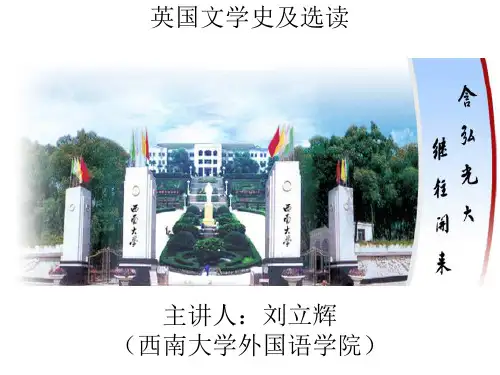
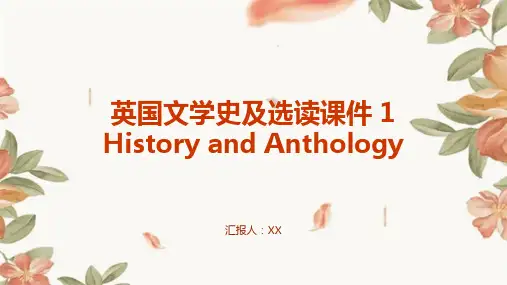
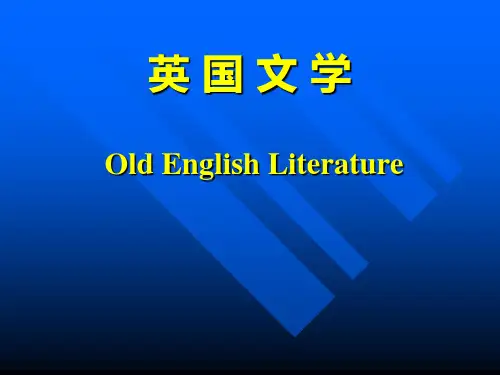
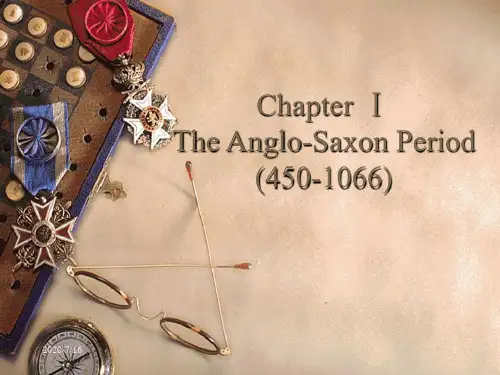

A General IntroductionMain content:A Brief Introduction to the History of British LiteratureTime:the 1st and 2nd hoursTextbook:History and Anthology of English Literature by Wu WeirenObjective:Make students have a basic frame of the development of British literature so that they may not feel difficult in understanding the main characteristics of the British literature at different time of British history.I. Early and Medieval English Literature (449—1500)1. the Anglo-Saxon PeriodIn 55 B.C., Britain was invaded by Julius Ceaser, the Roman conqueror. The roman occupation lasted about 400 years. In 410 A.D., all the Roman troops went back to the continent and never returned. Thus ended the Roman occupation in Britain. At this time, Britain was invaded by swarms of pirates. They were three tribes from Northern Europe: the Angles, Saxons and Jutes. They landed on the British coast, drove the Britons west and north, and settled down themselves. They established different kingdoms. By the 7th century, these small kingdoms were combined into a united kingdom called England, or the land of Angles. The three tribes had mixed into a whole people called English, the Angles being the most numerous of the three. And the three dialects spoken by them naturally grew into a single language called Anglo-Saxon, or old English.English literature began with the Anglo-Saxon settlement in England. Of old English literature, five relics are still preserved. All of them are poems, or songs by the Anglo-Saxon minstrels who sang of the heroic deeds of old time to the chiefs and warriors in the feasting-hall. Four are short fragments of long poems. But there is one long poem of over 3,000 lines. It is Beowulf, the national epic of the English people.2. Feudal EnglandThe French-speaking Normans under Duke William came to Britain in 1066. After defeating the English at Hastings, William was crowned as King of England. Revolts were cruelly suppressed and the conquest was completed with violence. It was called the Norman Conquest. William the Conqueror ruled England with a high hand. He pushed England well on its way to feudalism, and the Norman Conquest marks the establishment of feudalism in England.In feudal England, the society was divided into two distinct classes—landlords and peasants. The class conflict was fierce. In 1381, a rising took place.The most prevailing kind of literature in feudal England was the romance. It was a long composition, sometimes in verse, sometimes in prose. It described the life and adventures of a noble hero.William Langland is an important poet. His Piers the Plowman is a poem of over 7,000 lines. Most of the written literature in feudal England was intended only for the upper class. The English people had a literature of their own, not written but oral. English folk songs had existed long before the Norman Conquest. The song tradition continued after it. The most important department of English folk literature is the ballad.As to the poetry, Geoffrey Chaucer is the founder of English poetry. His The Canterbury Tales is his masterpiece and one of the monumental works in English literature.II. The Renaissance Period (1500—1660)The rise of the bourgeoisie soon showed its influence in the sphere of cultural life. The result is an intellectual movement known as the Renaissance, or the rebirth of letters. Originally, “Renaissance” means the “revival of learning”.It sprang first in Italy in the 14th century and gradually spread all over Europe.Two features are striking of this movement. The one is a thirsting curiosity for the classical literature. Another feature of the Renaissance is the keen interest in the activities of humanity. Humanism is the key-note of the Renaissance.In the days of Henry VIII (1509—1547), there were a group of scholars called Oxford Reformers, who introduced the classical literature to England and strove to reform education on a humanistic line. The greatest of the English humanists was Thomas More, the author of Utopia, Christopher Marlowe, and William Shakespeare.The highest glory of the English Renaissance was its drama. Famous dramatists are Marlowe, Shakespeare and Ben Johnson.As for poetry, sonnets become very popular. Famous poets were Philip Sydney, Edmund Spenser, etc. Metaphysical poems appeared at this time, headed by John Donn.Prose became popular as well. Francis Bacon is famous for prose writing.III. Neoclassicism period (1660—1798)The beginning of this period is the Restoration Period (1660—1688)(restoration of Stuart Monarchy). It was a period of reaction and degeneration. As soon as Charles II came back to Britain in 1660, the theatres were reopened and drama, esp. Comedy, flourished. But under the patronage of the king, it became only an entertainment of the corrupt court. At the same time, English literature of the Restoration period was modelled on the literature of France where classicism was then prevailing. The classicists upheld reason, law and order in literature instead of the free expression of man’s in dividuality in the Renaissance. According to classicism, drama, poetry and prose should all be controlled by some fixed rules. The English poets and writers of the Restoration wrote under this influence. John Drydon was the forerunner of the English classical school of literature.The “Glorious Revolution” of 1688 ended in a compromise between the aristocracy and bourgeoisie. England became a constitutional monarchy and power passed from the king to the Parliament and the Cabinet ministers. In the 18th century, the Industrial Revolution took place. Great changes also took place in rural England. The Enclosure Movement and expropriation of peasants begun in the 15th century was completed in the 18th century. The landless peasants went to the cities and became workers who owned nothing but labour and had to work long hours for low wages. The people in towns and villages protested against the unbearable conditions of life. Throughout the 18th century numerous uprisings broke out in the country.The 18th century marked the beginning of an intellectual movement in Europe, known as the Enlightenment. On the whole, it is an expression of struggle of the bourgeoisie against feudalism. England had gone through its bourgeois revolution in the 17th century. English enlighteners of the 18th century stove to bring it to an end by clearing away the feudal ideas with the bourgeois ideology. The representatives of the Enlightenment in English literature were Joseph Addison and Richard Steele, the essayists, and Alexander Pope, the poet. In their works, these writerscriticized different aspects of contemporary England, discussed social problems, and even touched upon morality and private life. They intended to reform social life according to a more reasonable principle, though this principle could never go beyond the limit of bourgeois interests. The literature of the Enlightenment in England mainly appealed to the middle class readers.The classicists modelled themselves on Greek and Latin authors, and tried to control literary creation by some fixed laws and rules drawn from Greek and Latin works. Drama, poetry and prose all followed some standards of classicism.The basic difference between Drydon and the 18th century enlighteners lie in the fact that the former wrote to please the declining aristocracy during the restoration period while the latter wrote for the rising bourgeoisie to tidy up the capitalist social order. Thus, owing to the need of the English middle class, classicism achieved a rapid growth and prevailed for the better part of the 18th century. After Pope, English classicism found still another exponent in Samuel Johnson.The novel is the most important gift of bourgeois civilization to the world’s imaginative culture. The modern European novel began after the Renaissance, with Cervantes’s “don Quixote”(1605—1615). The modern English novel began two centuries later. The rise and growth of the realistic novel is the most prominent achievement of 18th century English literature, which has given the world such novelists as Defoe, Swift, Richardson, Fielding, Smollett and Sterne.Swift’s world-famous novel “Gulliver’s Travels” typifies the bourgeois world in the repellent images of man-like creatures—Yahoos. He also drew ruthless pictures of the depraved aristocracy and satirically portrayed the whole of the English state system.Defoe’s “Robinson Crusoe” was one of the forerunners of the English realistic novel.It creates the image of an enterprising Englishman, typical of the English bourgeois of the 18th century.The development of the English novel was continued by Richardson. He wrote his first novel “Pamela” by accident.Fielding’s novels unfold a panorama of life in all sections of English society.He exposed the depraved aristocracy, the avaricious bourgeoisie and contrasted the luxurious life of the ruling classes with the misery of the people. He was the real founder of the realistic novel in England. He showed in his masterpiece “Tom Jones” the whole of the life of 18th century England as he saw it. His first novel was “Joseph Andrews”.Another 18th century novelist of the realistic school was Smollett, the author of Rodrick Random and Humphry Clinker.The new element of sentiment or sensibility was added to the novel by Sterne. His “Tristram Shandy” is a very strange novel in English literature.The 18th century was the golden age of English novel. The novel of this period spoke the truth about life with an uncompromising courage. The novelists of this period understood that “the job of a novelist” was to tell the truth about life as he saw it.In drama, Richard Brinsley Sheridan’s comedy was important.His masterpiece is The School for Scandal.In the first half of the 18th century, Pope was the leader of English poetry and the heroic couplet the fashion of poetry. By the middle of 18th century, sentimentalism turned to the countryside for its material (classicism and confined its material to the clubs and drawing-rooms, the social and political life of London), though its form was still in a classical style. The poetry of the sentimentalists is marked by a sincere sympathy for the poverty-stricken expropriatedpeasants. The appearance and development of sentimentalist poetry marks the midway in the transition from classicism to its opposite — romanticism in English poetry. The representative was Thomas Gray.In the latter half of the 18th century, a new literary movement arose in Europe, called the Romantic Revival. It was marked by a strong protest against the bondage of classicism, by a recognition of the claims of passion and emotion, and by a renewed interest in medieval literature. In England, this movement showed itself in the trend of Pre-romanticism in poetry. This trend was ushered by Percy, Blake and Burns.IV. Romanticism in English Literature (1798—1832)At the turn of the 18th and 19th centuries romanticism appeared in England as a new trend in literature. It rose and grew under the impetus of the Industrial Revolution and French Revolution. It was the product of the social conflicts.Generally speaking, the romanticists expressed the ideology and sentiment of those classes and social strata who were discontent with, and opposed to, the development of capitalism. But owing to difference in political attitudes, they split into two schools. Some romantic writers reflected the thinking of classes ruined by the bourgeoisie, and by way of protest against capitalist development turned to the feudal past, i.e. the “merry old England” as their ideal.These were the older and sometimes called passive, or escapist romanticists. The representatives are Wordsworth, Coleridge and Southey. Others expressed the aspirations of the classes created by capitalism and held out an ideal of a future society free from oppression and exploitation. These were the younger and sometimes called active romanticists represented by Byron, Shelley and Keats.The general feature of the works of the romanticists is the dissatisfaction with the bourgeois society, which finds expression in a re volt against prosaic, sordid daily life, against the “prison of the actual” under capitalism.The romanticists paid great attention to the spiritual and emotional life of man. Nature also plays an important role in their works. The passions of man and the beauties of nature appealed strongly to the imagination of the romantic writer, and the glory of lakes and mountains, the little joys or sorrows of children, the weal and woe of ordinary uncultured peasants, the wonder of the fairy world, and the splendour of the Greek art all became the fountain-heads of the writer’s inspiration.Poetry is the best medium to express all these sentiments. The romantic period was one of poetic revival.The great novelists in this period were Walter Scott and Jane Austen. Their works combines a romantic atmosphere with a realistic depiction of historical background and common people’s life. They marked the transition from romanticism to the period of realism which followed it. Romantic prose of the time was represented by Lamb, Hazlitt, De Quincey and Hunt.V. Victorian Age (1836—1901)—The Age of Critical RealismThe Chartist Movement took place in this period. It played an important role in the development of English progressive literature in connection with the working class movement. In this period of tense class struggle appeared a new literary trend—critical realism. The English critical realism of the 19th century flourished in the 40s and early 50s. The critical realists described with much vividness and great artistic skill the chief traits of the English society and criticized the capitalist system from a democratic viewpoint. The greatest English realist of the time was Charles Dickens. With striking force and truthfulness, he creates pictures of bourgeoiscivilization, describing the misery and sufferings of the common people. Other critical realists were William Makepeace Thackeray and Thomas Hardy.In prose writing, thomas Carlyle, John Ruskin, Mathew Arnold, Thomas Babington Macaulay were important.The poetry in this period experienced some new ways of expression. Important poets were Robert Browning and his wife Elizabeth Barrett (Mrs. Browning), and two Rossettis (Dante Gabriel Rossetti and Christina Georgina Rossetti).At the end of the 19th century, some literary trends appeared in the English literature. In fiction, naturalism was important. According to the theory of naturalism, literature must be “true to life” and exactly reproduce real life, including all its details without any selection. Naturalist writers usually write about the lives of the poor and oppressed, or the “slum life”, but by giving all the details of life without discrimination, they can only represent the external appearance instead of the inner essence of real life. However, some of the best naturalistic novels may approach or even become forceful realistic literature because naturalism in reality was a development of realism. George Gissing wrote under the influence of naturalism in Britain.Another literary trend prevailing at the end of the 19th century was neo-romanticism. Dissatisfied with the drab and ugly social reality, and yet trying to avoid the positive solution of the acute social contradictions, some writers adopted this new trend. Neo-romanticism lays emphasis upon the invention of exciting adventures and fascinating stories to entertain the reading public. It led the novel back toward story-telling and to romance. Robert Louis Stevenson was a representative of neo-romanticism in English literature. Treasure Island made him famous. Another famous book was Kidnapped.Another trend was aestheticism. Its theory was “art for art’s sake”.Walter Pater was a representative in prose, and Oscar Wilde in drama. Oscar Wilde and Shaw were forerunners of modernist drama.VI. The 20th CenturyIn the early 20th century, realist novels continued to prevail. Famous realists were John Galsworthy, H. G. Wells, Arnold Bennet.The first 30 years of the 20th century marked the golden age of modernism. The representatives in fiction included James Joyce, Virginia Woolf, D. H. Laurence, Katherine Mansfield. In poetry, W.B. Yeats and T. S. Eliot were important. They two also played important roles in modernist drama. Lady Gregory and O’Casey tried in modern drama as well.Bernard Shaw has been regarded as the most famous dramatist in English literature after Shakespeare.。
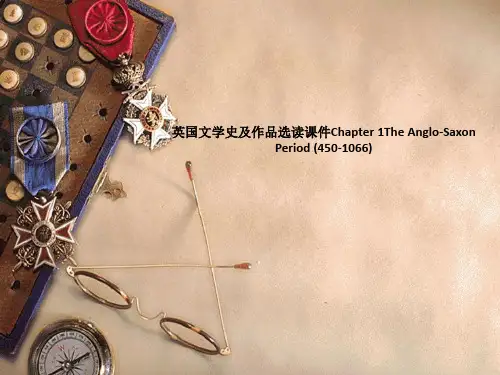

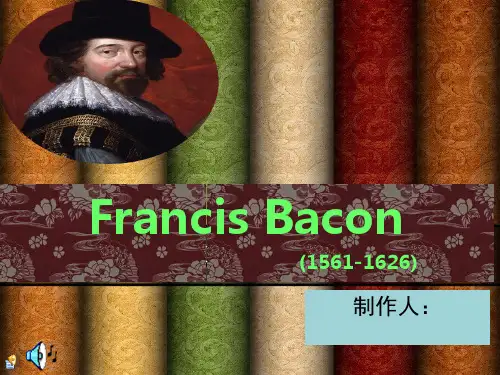
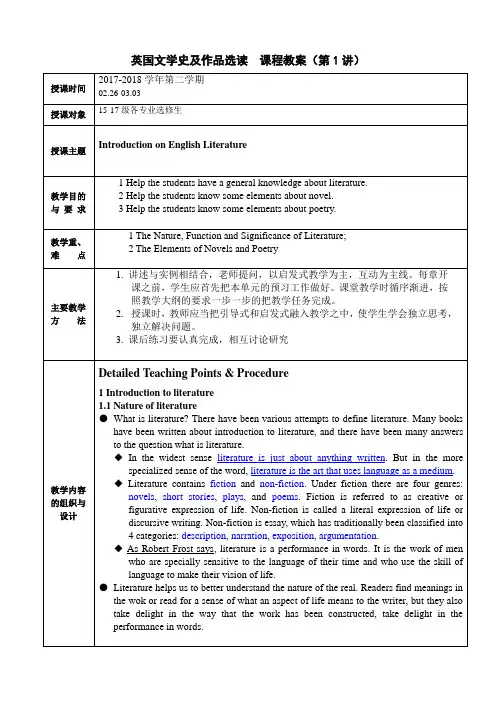
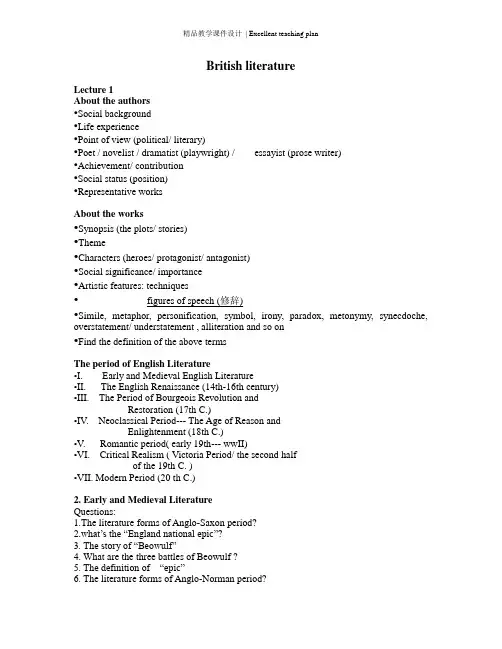
British literatureLecture 1About the authors•Social background•Life experience•Point of view (political/ literary)•Poet / novelist / dramatist (playwright) / essayist (prose writer) •Achievement/ contribution•Social status (position)•Representative worksAbout the works•Synopsis (the plots/ stories)•Theme•Characters (heroes/ protagonist/ antagonist)•Social significance/ importance•Artistic features: techniques•figures of speech (修辞)•Simile, metaphor, personification, symbol, irony, paradox, metonymy, synecdoche, overstatement/ understatement , alliteration and so on•Find the definition of the above termsThe period of English Literature•I. Early and Medieval English Literature•II. The English Renaissance (14th-16th century)•III. The Period of Bourgeois Revolution andRestoration (17th C.)•IV. Neoclassical Period--- The Age of Reason andEnlightenment (18th C.)•V. Romantic period( early 19th--- wwII)•VI. Critical Realism ( Victoria Period/ the second halfof the 19th C. )•VII. Modern Period (20 th C.)2. Early and Medieval LiteratureQuestions:1.The literature forms of Anglo-Saxon period?2.what’s the “England national epic”?3. The story of “Beowulf”4. What are the three battles of Beowulf ?5. The definition of “epic”6. The literature forms of Anglo-Norman period?7. What is “romance”?8.The class feature of the RomanceEpic (Heroic Poetry): This term is applied to great and lengthy narrative poems describing some important national enterprise or the adventures of distinguished heroes. (史诗)eg:Homer Odyssey《奥德赛》Dante’s Divine Comedy《十日谈》Milton Paradise Lost《失乐园》Romance: it was a long composition, sometimes in verse, sometimes in prose, describing the life and adventures of a noble hero.Class Feature of the Romance: the theme of loyalty to king and lord was repeatedly emphasized in romances, as loyalty was the corner-stone of feudal morality, without which the whole structure of feudalism would collapse.Sir Gawain and Green Knight 《高文爵士和緑衣骑士》3. ChaucerLife:⏹Born in a middle-classfamily in London⏹Is said to have studied atOxford and Cambridge⏹Became a man of affaires, undertaking various diplomatic missions to the Continent as courtier, diplomat and civil servant⏹Died in 1400,buried in Westminster Abbey, there established the poets’ corner Westminster Abbey (西敏寺)⏹An Abbey of monk on the bank of the Thames. The state church in England.⏹It was destroyed and rebuilt several times.⏹Chaucer w as first buried in the Abbey, then established “Poets’ corner”.⏹It is an honor for a poet or his monument to be buried there.Literary Career:⏹His experience gave him chance to obtain a good knowledge of Latin, French and Italian.⏹Three periods:The first period consists of works translated from French, as “The Romaunt of the Rose”The second consists of works adapted from the Italian, as “Troilus and Criseyde.”(based on Boccacio’s poem Filostrato)The third includes “The Canterbury Tales”, which is purely English.⏹Translator⏹“The father (founder) of English poetry” -- John Dryden⏹“Founder of English realism” -- GorkyThe first short-story teller and first morden poet in E.L.Forerunner of humanismThe City Canterbury⏹Canterbury is a city and metropolitan district in Kent England, and an important Romantown.⏹The capital of the Saxon Kingdom of Kent.The Canterbury Tales 《坎特伯雷故事集》⏹A collection of stories⏹Pilgrim, pilgrimage⏹The Tabard Inn, a tavern in Southwark, near London.⏹A gigantic plan of 124 stories, but only 24 were written.⏹The verse models Boccaccio’s Decameron in formThe Prologue (楔子)⏹A prologue is an introduction or preface, often in verse, to a literary work, esp. a play ⏹The prologue provides a framework for the tales. There is an intimate connection between the tale and the prologue, both complementing each other.The Gneral Prologue (the original version)Whan that Aprill, with his shoures sooteThe droghte of March hath perced to the roote,And bathed every veyne in swich licourOf which vertu engendred is the flour;Whan zephirus eek with his sweete breethInspired hath in every holt and heethThe tendre croppes, and the yonge sonneHath in the Ram his halve cours yronne,And smale foweles maken melodye.Heroic Couplet (Iambic pentameter英雄双韵体⏹A pair of rhymed lines of verse of equal length, in the form of ten syllables and five stresses in each line. It was first used by Chaucer. Its master is Alexander Pope.⏹Alliteration(头韵)An alliterative verse, certain accented words in a line begin the same consonants sound. Alliteration is the opposite of rhyme by which the similar sounds occur at the end of the syllables.Contribution⏹He presents a panoramic picture of English life in the Middle Ages.⏹He brought a realistic tone to English literary creation. All his characters are true to life ⏹He introduced Rhymed stanzas, instead of the old Anglo-Saxon (alliterative verse)⏹He first wrote in the current English form of the time. His poetry is acknowledged as the literary language of the country, which is usually called middle English.The language of Chaucer⏹Middle English --- is closer to Old English, the language of the Anglo-Saxons, and Norman French, the language of William the ConquerorFeatures in Chaucer’s writing⏹Rhymed stanzas of various type⏹Simplicity in characterization⏹Satirical and humorous tone⏹narrativeAbout the prioress⏹Higher orders of the religious group⏹Speaks French-- the aristocratic language⏹Tenderness, pity, gentility⏹Overly concern about her personal appearance ⏹Satiric tone。
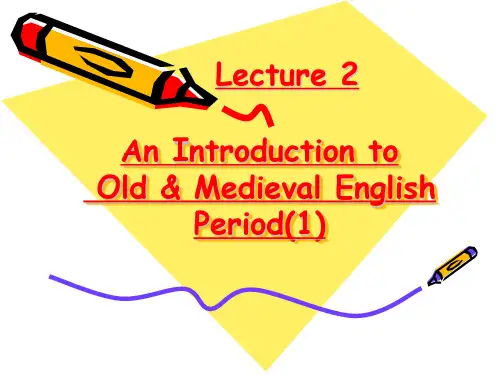
英国文学史及选读Chapter1英国文学史及选读Chapter1发布人:圣才学习网发布日期:2010-08-16 17:32 共270人浏览[大] [中] [小]The Anglo-Saxon PeriodI. Fill in the blanks.1.After the fall of the Roman Empire and athe withdrawl of Roman troops from Albion,the aboriginal __ population of the larger part of the island was soon conquerered and almost totally exterminated by the Teutonic tribes of ____,_____ ,and _____ who came from the continent and settled in the island,naming its central part a,or England.2.For nearly ______ years prior to the coming of the English,British had been a Roman province. In _____,the Rome withdrew their legions from Britain to protect herself against swarms of Teutonic invaders.3.The literature of early period falls naturally into teo divisions,and ____.The former represents the poetry which ____the Anglso-Saxons probably brought with them in the form of _____ ,the crude material out of which literature was slowly developed on English soil;the later represents the writings developed under the teaching of ______ .4._____can be justly termed England’s national epic and its hero _____---one of the national heros of the English people.5.The Song of Beowulf reflects events which took place on the ______ approximately at the beginning of the_____century,when the forefathers of the Jutes lived in the southern part of the _____ and maintained close relations with kindred tribes,e.g.with the ______ who lived on the other side of the straits.6.Among the early Anglo-Saxon poets we may mention______ who lived in the latter half of the ______ century and who wrote a poetic Paraphase of the Blible.7.____ is the first known religious poets of England. He is known as the father of English song.8.The didac tic poem “The Christ” was produced by ________.II. Choose the best answer for each blank.9.The most important work of _______ is the Anglo-Saxon Chronicles,which is regarded as the best monument of the old English prose.a. Alfred the Greatb. Caedmonc. Cynewulfd. Venerable Bede2. Who is the monster half-huamn who had mingled thirty warriors in The Song of Beowulf?a. Hrothgat.b. Heorot.c. Grendel.d. Beowulf.3. _____ is the first important religious poet in English Literature.a. Cynewulfb.Caedmonc. Shakepeare.d. Adam Bede4. The epic,The Song of Beowulf,represents the spirit of ______.a. monksb. romanticistsc. sentimentalistd. paganIII. Decide whether the following statements are true or false and write your answers in the brackets.1. ()The author of The Song of Beowulf is Cynewulf.2. ()The setting of The Song of Beowulf is in Scotland.3. ()Alfred the Great compiles The Anglo-Saxon Chronicles.4. ()Venerable Bede wrote The Ecclesiastical History of the English People.5. ()The author of Paraphase is Caedmon.IV. Define the liretary terms listed below.Alliteration Epic.V. Answer the following questions.1.What do you know about the Teutors.2.Please give a brief description of The Song of Boewulf.英国文学史及选读Chapter2发布人:圣才学习网发布日期:2010-08-16 17:31 共93人浏览[大] [中] [小]The Anglo-Norman PeriodI. Fill in the following blanks.1.In the year___,at the battle of ___,the ____ headed by William,Duke of Normandy,defeated the Anglo-Saxons.2.The literature which Normans brought to England is remarkable for its bright,____ tales of _______ and _______,in marked contrast with the ___ and ______ of Anglo-Saxon poetry.3.English literature is also a combination of ____and _____ elements.4.In the 14th century,the two most important writers are ___ and Chaucer.5.In the 15th century,there is only one important prose writer whose name is _____. He wrote an important work called Morte d’ Arthur.II. Define the leterature terms listed below.1.Canto2.legend3.Arthurian Legend.III. Read the excerpt of Sir Gawain and the Green Knight carefully,and then make a brief comment on it.IV. Answer the following questions.1.What is the consequence of the Norman Conquest?2.Make a brief survey of the middle English literature.英国文学史及选读Chapter3发布人:圣才学习网发布日期:2010-08-16 17:31 共68人浏览[大] [中] [小]Geoffrey ChaucerI. Fill in the following blanks.1.Chaucer’s masterpiece is _____,one of the most famous works in all literature.2.Chaucer created in The Canterbury Tales a strikingly brilliant and picturesque panorama of _______.3.There are various kinds of ballads _______,______,______,_____,and ______.4.Bishop ____ was among the first to take a literary interest in ballads.5.The name of the “jolly innkeeper” in The CanterburyTales is ______,who proposes that each pilgrim of the ____ should tell two tales on the way to Canterbury and two more on the way back.6.In contradistinction to the ______ verse of Anglo-Saxon poetry,Chaucer chose the metrical form which laid the foundation of the English _____ verse.II. Choose the best answer.1.Who is the “father of English poetry” and one of the greatest narrative poets of England?a. Christopher Marlowb. Geoffrey Chaucerc. W. Shakespeared. Alfred the Great2. Chaucer’s earlist work of any length is his “______” a transl ation of the French “Roman de la Rose” by Gaillaume de Lorris and Jean de Meung,which was a love allegory enjoying widespread popularity in the 13th and 14th centuries not only in France but throught Europe.a. Troilus and Criseydeb. A Red,Red Rosec. Romance of the Rosed. Piers the Plowman3. In his literary development,Chaucer was influenced by three literatures,which one is not true?a. French literature.b. Italian literaturec. English literatured. American literatureIII. Decide whether the following statements are true or false and write your answers in the brackets.1. ()The 32 pilgrims,according to Chaucer’s plan,was to exceed that of Baccoccio’s Decameron.2. ()The Prologue is a splendid masterpiece of Romantic portray,the first of its kind in the history of English literature.3. ()The Canterbury Tales is a vivid and brilliant reflection of 15th century in England.4. ()Chaucer’s poetry traces out a path to the literature of English Renaissance.IV. Define the leterary terms listed below.1.Romance.2.Fable.3.BalladV. Anwer the following question.1.What is the social significance of The Canterbury Tales ?英国文学史及选读Chapter4发布人:圣才学习网发布日期:2010-08-16 17:30 共66人浏览[大] [中] [小]The RenaissanceI. Complete each of the following statements with a proper word or phrase according to the textbook.1.Shakespeare’s first priginal play written in about 1590 was _________.2.Hamlet,Othello,King Lear,and _______ are generally regarded as Shakespeare’s four great tragedies.3.The Tragical History of Doct or Faustus is one of _______’s best known sonnets.4.Absolute monarchy in England reached its summit during the reign of ______.5.Bacon’s works may be divided into three classes,the ______,the _______,the _______ works.6.Together with the development of bourgeois relationships and formation of the English national state this period is marked by a flourishing of national culture known as the_________.7.Edmund Spenser was the author of the greatest epic poem of _______.II. Find out the author and his works.⑴The author and their works1. ()Thomas More a. Gorge Green2. ()Enmund Spenser b. Eupheus3. ()John Lyly c.The Fairy Queen4. ()Marlowe d. Utopia5. ()Robert Greene e. The Jew of Malta⑵The characters in the play1. ()Desdemona a. The Merchant of Venice2. ()Cordelia b. As you like it3. ()Juliet c.Hamlet4. ()Ophelia d. King Lear5. ()Portia e. Othello6. ()Rosalind f. Romeo and JulietIII. Define the leterary terms listed below.1.Renaissance2.sonnet3.Spenserian Stanza4.Humanism5.dramatic irony6.tragedy7.allusionIV. Answer the following questions.1.Give a summary about the English literature during the Renaissance period.2.What is the main idea of Hamlet?3.Give a brief introduction to Thomas More’s Utopia.4.Wh en were Shakespeare’s main tragedies written?what did he write about in his tragedies?英国文学史及选读Chapter5发布人:圣才学习网发布日期:2010-08-16 17:29 共40人浏览[大] [中] [小]Chapter Five The Period of Revolution and RestorationI. Complete each of the following statements with a proper word or phrase according to th etextbook.1.The 17th century was a period when ______ impeded the further development of capitalism in England and the ______ could no longer bear the sway of _______.2.England became a commomwealth under the leadership of _______.3.The Glorious Revolution in _____ meant three things the supremacy of ________,the beginning of _______,and the final truiumph of the principle of _______.4.Restoration created a literature of its own,that was often ______ and _______,but on the whole _______ and _______.5.The first thing to strik e the reader is Donne’s extraordinary _____ and penetrating_______. The next is the ______ which marks certain of the lighter poems and which represents a conscious reation from the extreme _______ of woman encouraged by the Petrachan tradition.6.Parad ise Lost presents the author’s view in an ______,_______ form. It is based on the _______legend of the imaginary progenitors of the human race-______,and _______,and involves God and his eternal adversary _____in its plot.7.Bunyan’s most important wo rk is _________,written in the old-fashioned,medieval form of ________ and _________.8.Christia has two objects,---to get rid of his ______,which holds the sins and fears of his life,and to make his way.II. Find out the work from column A and its content from column B.1. ()II Penseroso a. defense of the Revolution2. ()Lycidas b. Satan against God3. ()Comas c. about dear friend4. ()Areopagitica d. happiness5. ()Eikonolastes e. meditation6. ()Defense for the English People f. masque7. ()Paradise Lost g. attack on the censorship8. ()L’Allegro h. justifying the excutionIII.Define the leterature terms listed below.1 .Blank Verse2. Three Unities3. Conceit4. Stanza5. Elegy6 .Allegory7. GenreLiterary CriticismIV. Answer the following questions.1.What are the different aspects between the literature of Elizabeth period and that of the Revolution period?2.Give a brief analysis of Satan,the central figure in ParadiseLost.3.Why do people say Samson is Milton?4.In your opinion,why is “The Pilgrim’s P rogress” successful?英国文学史及选读Chapter6发布人:圣才学习网发布日期:2010-08-16 17:29 共34人浏览[大] [中] [小]The Age of Enlightenment EnglandI. Complete each of the following statements with a proper word or phrase according to th etextbook.1.The Revolution of 1688,which banished the last of the _____ kings,marks the end of the long struggle for political freedom in England.2.Another feature of the age was the rapid development of _________.3.It is simply for convenience that we study 18th century writings in three main divisions:the reign of so-called _____,the revival of _______ poetry,and the beginnings of the _______.4.The philosophy of the nlighteners,though ________ ________ and _________ in its essence,did not exclude senses,or sentiments,as a means of perception and learning.5.The most outstanding figure of English sentimentalism was ________.6.The Tarler and _______ _________ were Steele and Addison’s chief contribution to English literature.7.Robinson Crusoe is largely an ______ ________ ________ story,rather than the study of ______ _______ which Defoe probably intended it to be.8.Gulliver’s adventures begins with ______________,who are so small that Gulliver isa giant among them.9.The poem,which Addison named ______ _______,was hailed throughout England as a great work.10.In the essays of the 16th century,French writer ____ set the model for more familiar,personal and discursive discussion.11.Fielding’s laternovels are _______________,was inspired by the success of Ri chardson’s novel Pamela.12.As________,Goldsmith is among the best of the century.13. The greatest of _______ poets is Robert Burns.II. Match the theirs works in column A writers/genres with in column B.⑴1. ()The Deserted Village a. Thomas Gary2. ()The Village b. George Crabble3. ()Elegy Written in a Country Churchyard c. Oliver Goldsmith4. ()The Seasons d. James Thomson5. ()The Rape of the Lock e. William Blake6. ()The Chimney Sweeper f. Alexander Pope7. () A Red,Red Rose g. Robert Burns⑵1. ()A Sentimental Journey a. Daniel Defoe2. ()The Vicar of Wakefield b. Jonathan Swift3. ()The School for Scandal c.John Bunyan4. ()The History of a Young Lady d. Horace Walpole5. ()Tom Jones e. Laurence Sterne6. ()The Adventures of Peregrine Pickle f. Oliver Goldsmith7. ()Robinson Crusoe g. Richard B. Sheridam8. ()Gulliver’s Tra vels h. Samuel Richardson9. ()The Castle of Otranto i. T. G. Smollet10.()The Pilgrim’s Progress j. Fielding.⑶1. ()The Vicar of Wakefield a. essay2. ()She Stoops to Conquerb. poem3. ()The Citizen of the world c. novel4. ()The Deserted Village d. comedyIII.Define the leterature terms listed below.1.Enlightenment Movement2.Realistic Novel3.Gothic novel4.Heroic Couplet5.Mock Epic6.Bildungsroman7.Epitaph8.Farce9.Imagism10.RhymeIV. Answer the following questions.1.What is Pope’s position in English literature?2.What are the features of Sterne’s novels?3.What are the narrative festures of Gulliver’s Travel?4.What is Dr. Johnson’s comment on Addison’s prose?5.What is Fielding’s style?6.Why is Burn’s poetry important?英国文学史及选读Chapter7发布人:圣才学习网发布日期:2010-08-16 17:28 共27人浏览[大] [中] [小]The Romantic PeriodI. Fill in the following blanks.1.With the publication of William Wordworth’s _____ in Collaboration with S. T. Coleridge,________ began to bloom and found a firm place in the history of English literature.2.The most important and decisive factor in the develoment of literature is _____,English Romanticism was greatly influenced by the _______ and _______.3.The greatest historical novelist _____ was produced in the Romantic Age.4.Byron is chiefly known for his two long poems,one is Childe Harold’s Pilgrimage,the other is ________.5.Shelley’s poem _______ (1816),is vaguely autobiographical acount of a youn g poet’s unsuccessful attempt to recapture his envisional ideal.6.Ode to a Nightingale was written by _______.II. Decide whether the following statements are true or false.1. The Romantics emphasized the special qualities of each individual’s mind.2.The brilliant literary criticiam Biographis literaria is written by Samuel Johnson.III. Write the author of the following literary works.1. Song of Innocence2. The Prelude3. Kubla Khan4. Don Juan5. Prometheus Unbound6. Ode to the West Wind7. Ode on a Greciam Urn8. Pride and Prejudice9. Poor RelationsIV. Match the authors in column A with the works in columnB.1. Dante a. I Wandered Lonely as a Cloud2.Byron b. Ode to a Nightingale3. Wordsworth c. Gain4. Keats d. Prometheus Unbound5. Shelley e. Divine ComedyV. Define the following terms.1.Romanticism/doc/a410999246.htmlke poetsVI. Answer the following questions.1.How does Wordsworth define the poet?2.What kinds of stylistic devices are used in Ode to the West Wind?3.Co mment on Austen’s writing festures.英国文学史及选读Chapter7发布人:圣才学习网发布日期:2010-08-16 17:28 共27人浏览[大] [中] [小]The Romantic PeriodI. Fill in the following blanks.1.With the publication of William Wordworth’s _____ in Collaboration with S. T. Coleridge,________ began to bloom and found a firm place in the history of English literature.2.The most important and decisive factor in the develomentof literature is _____,English Romanticism was greatly influenced by the _______ and _______.3.The greatest historical novelist _____ was produced in the Romantic Age.4.Byron is chiefly known for his two long poems,one is Childe Harold’s Pilgrimage,the other is ________.5.Shelley’s poem _______ (1816),is vaguely autobiographical acount of a young poet’s unsuccessful attempt to recapture his envisional ideal.6.Ode to a Nightingale was written by _______.II. Decide whether the following statements are true or false.1. The Romantics emphasized the special qualities of each individual’s mind.2.The brilliant literary criticiam Biographis literaria is written by Samuel Johnson.III. Write the author of the following literary works.1. Song of Innocence2. The Prelude3. Kubla Khan4. Don Juan5. Prometheus Unbound6. Ode to the West Wind7. Ode on a Greciam Urn8. Pride and Prejudice9. Poor RelationsIV. Match the authors in column A with the works in columnB.1. Dante a. I Wandered Lonely as a Cloud2.Byron b. Ode to a Nightingale3. Wordsworth c. Gain4. Keats d. Prometheus Unbound5. Shelley e. Divine ComedyV. Define the following terms.1.Romanticism/doc/a410999246.htmlke poetsVI. Answer the following questions.1.How does Wordsworth define the poet?2.What kinds of stylistic devices are used in Ode to the West Wind?/doc/a410999246.htmlment on Austen’s writing festures.英国文学史及选读Chapter9发布人:圣才学习网发布日期:2010-08-16 17:26 共37人浏览[大] [中] [小]The 20TH Century LiteratureI. Fill in the following blanks.1.Those “novels of character and enviorement” by T homas Hardy are the most representative of him as both a _______ and a critical realist writer.2.The trilogy “The Forsyte Saga” consists of The Man of Propert y,In Chancery and_________./doc/a410999246.htmlwrence first novel,_________________,was received with respect.4.Virginia Woolf’s novel ________________,published in 1925,made her reputation as an important psychological writer.5._________is the m ost outstanding stream of consciousnessnovelist.II. Define the literary terms.1.Imagism2.ModernismIII. Find the relevant match from column B for each item in column A.1. James Joyce a. Neo-classicism2. Ezra Pound b. An active romantic3. William Wordsworth c. Humanism4. Oscar Wilde d. Transcendantalism5. Walter Scott e. A radical enlightenner6. Alezander Pope f. Imagism7. Johanthan Swift g. Aestheticism8. Percy Bysshe Shelley h. A lake Poet9. William Shakespeare i. Stream of consciousness10. Henry,David Thoreau j. A historical novelistIV. Give a brief comment on the c haracteristic of Hardy’s novels.。